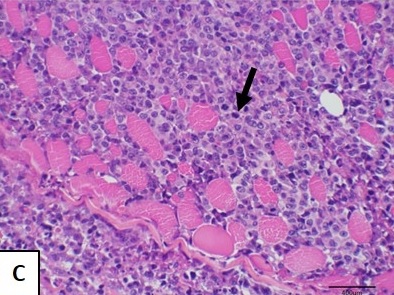Cutaneous non-epitheliotropic large T-cell lymphoma in an English Bulldog
DOI:
https://doi.org/10.24070/bjvp.1983-0246.v13i3p622-627Keywords:
neoplasm, canine, round-cell tumor, lymphocytes, skinAbstract
Cutaneous lymphoma is histologically classified in epitheliotropic and non-epitheliotropic, the first showing higher incidence in dogs, and the second, in cats. Non-epitheliotropic lymphoma presents lymphocyte aggregates in the dermis and subcutaneous tissue, however cutaneous annexes are not infiltrated. It is usually more aggressive than epitheliotropic lymphomas. The aim of this study was to report a case of non-epitheliotropic lymphoma in a 9-year-old, female, English Bulldog presented with non-ulcerated skin nodules adhered to deep tissues. Microscopic and immunophenotypic features supported the diagnosis of non-epitheliotropic large T-cell lymphoma. Treatment was initiated with modification of the LOPP protocol, replacing procarbazine by dacarbazine (600 mg/m²) for up to six cycles, with a three-month survival. In the 11th week of treatment, after recurrent episodes of vomiting and diarrhea, abdominal ultrasound was performed and revealed an infiltrative mass in the stomach's greater curvature topography, showing an expansive and accentuated increase in one week, when euthanasia was elected.


